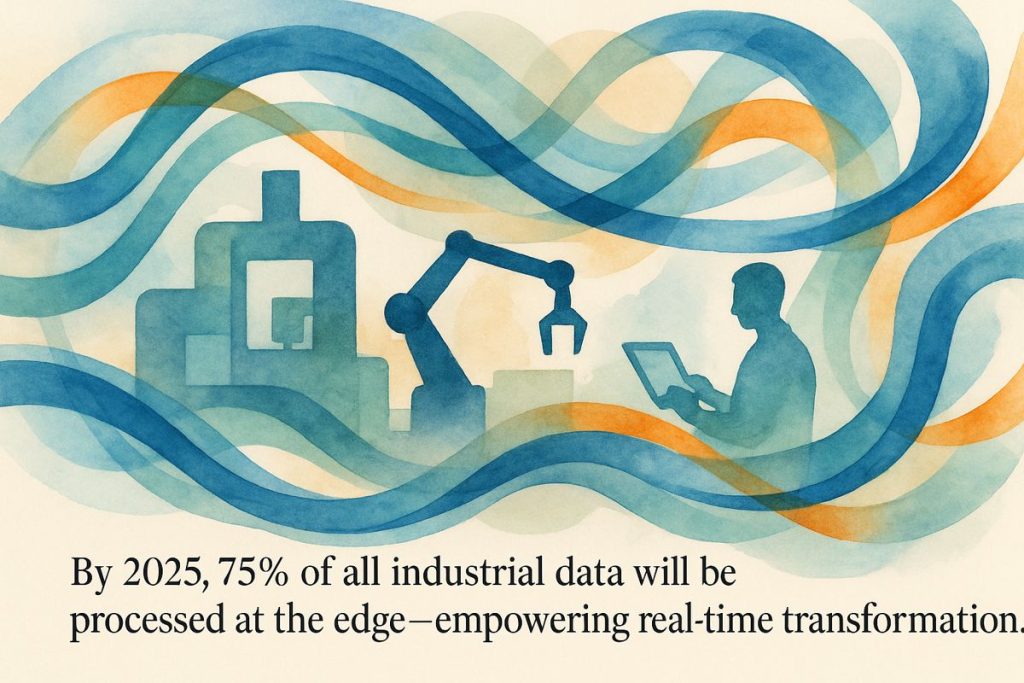Industrial Edge AI brings smart, lightning-fast decision-making right onto the factory floor, where machines learn and react in real time, not waiting for distant servers. In places like pharmaceutical plants, Edge AI keeps things running smoothly catching tiny errors, predicting breakdowns, and protecting sensitive data by processing it onsite. Robots spot defects in milliseconds, while clever algorithms tweak every step for perfect products and less waste. Even if the internet goes down, these smart systems keep working, making factories safer, faster, and more reliable than ever before.
What are the benefits of Industrial Edge AI in manufacturing?
Industrial Edge AI in manufacturing delivers real-time, local processing for ultra-low latency decision-making, enhances operational resilience, ensures data privacy and security, improves quality control with machine vision, enables predictive maintenance to reduce downtime, and optimizes production processes boosting yield and ensuring compliance in highly regulated industries.
Coffee Stains and Circuit Boards
Let s set the scene. Picture a pharmaceutical plant at dawn: the whirring of bottling machines, the sharp tang of ethanol lingering in the air, and somewhere always a sensor blinking its cryptic Morse code. If you squint, it feels less like a factory and more like a palimpsest of competing priorities: compliance, quality, speed, and that old industrial chestnut don t break anything expensive by mistake. Years ago, I spent a week shadowing an engineer at Novartis, and the memory of a rogue vibration sensor chirping at 3�a0a.m. still makes my left eye twitch. That was before edge AI began elbowing its way onto the shop floor.
So why this sudden romance with edge AI? (And will it last, or is it just another infatuation a technological crush doomed by harsh Monday mornings?) For highly regulated sectors like pharma and life sciences, where a single microgram out of place can spell disaster or a decade in court, the answer is simple: real-time, local intelligence. No more waiting for the cloud s approval; the edge lets machines think for themselves, milliseconds after something extraordinary or dangerous occurs.
Real-Time Grit: When Algorithms Live on the Edge
Edge AI, in its stripped-down, caffeine-jittery glory, means running artificial intelligence directly where the action is: on sensors, PLCs, or embedded gateways bolted to the walls of your cleanroom. Not in some ethereal cloud data center, but right there in the realm of rust and rubber gloves. As InHand Networks points out, this local processing yields ultra-low latency. Need a robotic arm to halt instantly when it detects a glass vial out of place? Edge AI does it in roughly the time it takes your eyelid to twitch think 10 milliseconds, not ten seconds.
Of course, it s not only about speed. There s resilience too. If the factory loses its fiber-optic leash to the cloud, edge devices keep humming along, making decisions autonomously. That s not just a technical luxury; for pharmaceuticals, where a botched batch halts a supply chain or endangers patients, operational continuity is sacred. VIA Technologies has seen edge units keep sterile processes marching on, even as the central server did its best impression of a stunned goldfish.
Let s not forget privacy and security because nothing says career-ending audit like patient data leaking into the digital wilds. Edge processing keeps sensitive information onsite, meeting the bar for GDPR, HIPAA, or whatever three-letter agency keeps you up at night.
Concrete Magic: From Quality Control to Quantum Leaps
Here s where the abstract gets deliciously tactile. Quality assurance used to mean an army of inspectors squinting at pill bottles (and, I imagine, quietly envying the robots). Now, machine vision systems at the edge spot defects, underfills, or misaligned labels in real-time every 0.2 seconds, by one XenonStack case study I stumbled across. It s a bit like having a hyperspectral eagle perched over your production line.
Predictive maintenance is another arrow in the quiver. Edge AI models trained on months or years of vibration, temperature, maybe even sound (the whine of a misaligned bearing is oddly unforgettable) forecast equipment failure before it happens. During my own stint in a plant, I ignored a small rise in pump motor vibration data, convinced it was a fluke. Spoiler: it wasn t. Edge AI wouldn t have been so easily fooled; it learns from every spike, every “click” or “ugh” the machinery utters. According to Automation World, this not only slashes downtime but also keeps sterile processes where a single contaminant could cost millions running like clockwork.
Optimization is where things get a bit heady, almost philosophical. Algorithms fine-tune mixing speeds, adjust environmental conditions, and tweak chemical concentrations, all in search of the Platonic ideal of a perfect batch. Edge AI is the unseen conductor, keeping the industrial orchestra in key, learning and adapting with each crescendo. Barbara.tech describes cases where yield increased by 7% or more enough to make even the most jaded plant manager smile.
And let s not overlook logistics: AI-driven asset trackers monitor shipments, temperatures, and humidity, ensuring that biologics stay potent in transit. Real-time alerts mean a reefer truck s compressor failure is no longer a catastrophe but a minor hiccup, easily remedied before disaster strikes (InHand Networks again).
Trends, Surprises, and Lingering Fears
If you ask me, the winds have shifted for good. The silicon brains tucked into edge devices now rival yesterday s server rooms, thanks to the likes of NVIDIA s Jetson and Texas Instruments s Sitara series. 5G connectivity sweeps across industrial campuses like a digital monsoon, making real-time, decentralized collaboration not just possible, but inevitable (Barbara.tech.
